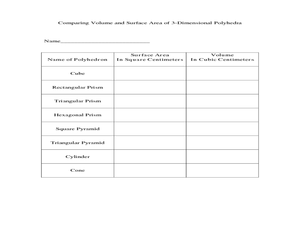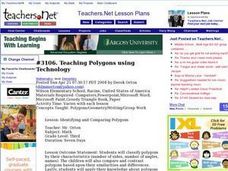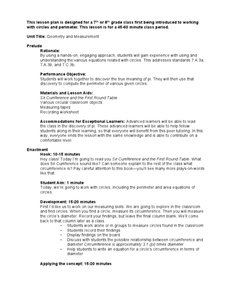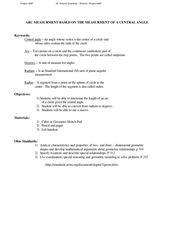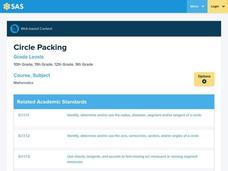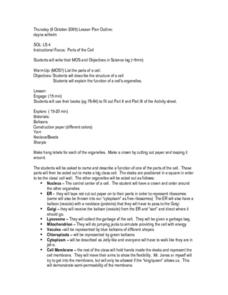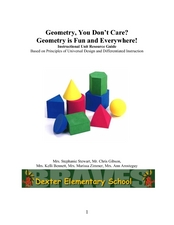Shodor Education Foundation
Volume of Prisms
Explore the concept of volume of prisms using an applet to perform the calculations. The link to the interactive applet is embedded into the lesson plan as well as a link to associated data sheets. Get your math class to the computer lab...
Curated OER
Worksheet 25 - Chain Rule
In this chain rule worksheet, students use the chain rule and substitution to find partial derivatives. They identify total surface area, and find the distance from the origin to the plane. This one-page worksheet contains seven...
Shodor Education Foundation
Surface Area of Rectangular Prism
With this interactive lesson plan, learners compute the surface area of rectangular prisms. They visit an online investigation applet and record data on the provided handout. Pair this lesson plan with the volume lesson plan by the same...
Curated OER
World Projections
Learners identify map projections and examine polar maps. In this map skills lesson, students use a flat world map to identify various projections and calculate the distances between locations by using a map scale.
Curated OER
Shaping Up with Nature at Black Bayou Lake
Students visit a local lake refuge and identify shapes they find in nature. They take pictures of the various shapes and use KidPix to draw shapes around the shapes in the pictures. They watch a slideshow of all the shapes found by their...
Curated OER
The Value of Volume
Students measure the perimeter and area of their polygons. In this geometry lesson, students calculate the volume and area using the correct tools. They calculate the time and temperature and the perimeter and side lengths of triangles.
Curated OER
Rep Tiles
Third graders use pattern blocks of one shape at a time to try to create a similar shape. They compare the perimeter of the new figure with the perimeter of the original shape and look for a pattern. Students use the pattern to predict...
Curated OER
Demonstrating the Distances of Stars
Students examine the distance from Earth to stars. They create a model to show the arrangement of constellations. They also identify the importance of the parallax effect.
Curated OER
Teaching Polygons using Technology
Third graders utilize different types of computer programs, such as Microsoft paint and Microsoft Word to study and create different types of polygons. They use PowerPoint to create a story about a shape and others that it meets during a...
Curated OER
How many isosceles triangles can you find?
Seventh graders recognize the characteristics of isosceles triangles. In this isosceles triangle lesson, 7th graders use geoboards to create isosceles triangles. Students record results and explain why they have an isosceles triangle.
Curated OER
Naming Shapes
Students study geometric shapes and practice naming them properly. In this geometry instructional activity, students work in groups to give definitions of the vocabulary to each other in their own words. Students also visit a lower grade...
Curated OER
Geoboard Squares
Students create squares of different sizes on a geoboard. They find and describe a pattern. Students use the pattern to determine the number of squares possible on a 10-by-10 geoboard. They create squares with a horizontal base (and...
Curated OER
Geometry and Measurement
Students view a right triangle displayed by the teacher. Students measure legs and the interior angles of the triangle. They look for a pattern or relationship between the legs and angles. Students use pegboards and string to create more...
Curated OER
Shape City
Students add to a class Shape City by designing and constructing new buildings.
Curated OER
Classifying Pyramids
Students study pyramids. For this prisms lesson, students explore the attributes of pyramids. Students will explore the lateral surface area of pyramids and be able to distinguish pyramids from other space shapes.
Curated OER
Surface Area and Volume of Similar Solids
Students explore similar figures. In this surface area and volume lesson, students identify the relationship between the surface area and volume of similar figures.
Curated OER
Measurement of a Central Angle
Students calculate the measurement of a central angle. In this geometry lesson, students identify properties of circles. They use Cabri software to create and analyze graphs.
Curated OER
Arc Measurement Based on The Measurement of a Central Angle
Students define keywords that are important to solve problems. In this geometry instructional activity, students find the arc length and angle of a circle. They convert between radians and degrees.
Curated OER
Circle Packing
Young scholars identify different parts and properties of circles. In this geometry lesson, students identify the radius, diameter, semicircle and inscribed angle of a circle. They identify the tangent lines to a circle.
Curated OER
Parts of the Cell
Students examine plant and animal cells to observe the organelles present in the cell, to match the function of each to the organelle on a cell model and to build a model of the plant or animal cell.
Curated OER
Geometry is Fun and EverywhereGeometry, You Don’t Care? Geometry is Fun and Everywhere
Third graders investigate shapes in our world. In this geometry lesson, 3rd graders describe plane and solid shapes and identify angles, solid objects and lines of symmetry. Students use online resources, graphic organizers and conduct...







